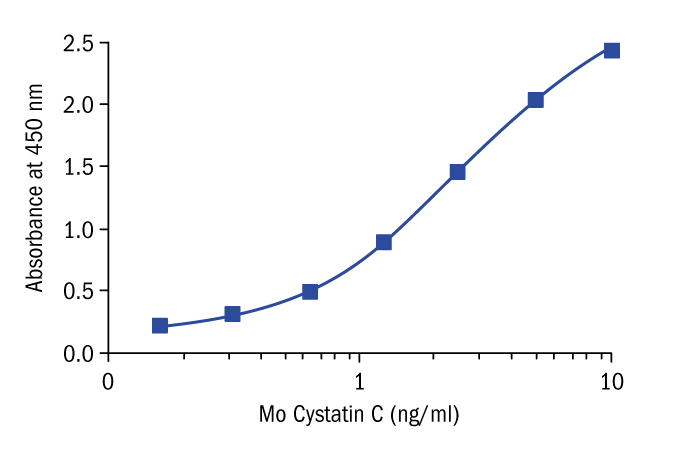Type
Sandwich ELISA, Biotin-labelled antibody
Applications
Serum
Sample Requirements
5 µl/well
Shipping
At ambient temperature. Upon receipt, store the product at the temperature recommended below.
Storage/Expiration
Store the complete kit at 2–8°C. Under these conditions, the kit is stable until the expiration date (see label on the box).
Calibration Curve
Calibration Range
0.156–10 ng/ml
Limit of Detection
0.04 ng/ml
Intra-assay (Within-Run)
n = 8; CV = 7.1%
Inter-assay (Run-to-Run)
n = 5; CV = 8.2%
Spiking Recovery
88,70%
Dilution Linearity
104,80%
Crossreactivity
- bovine Non-detectable
- cat Non-detectable
- dog Non-detectable
- goat Non-detectable
- horse Non-detectable
- hamster Yes (recommended dilution 1:100)
- human Non-detectable
- monkey Non-detectable
- pig Non-detectable
- rabbit Non-detectable
- sheep Non-detectable
- chicken Not tested
- mouse Yes
- rat Yes (recommended dilution 1:200)
Features
- It is intended for research use only.
- The total assay time is less than 3.5 hours.
- The kit measures total Cystatin C in mouse serum.
- Assay format is 96 wells.
- Quality Controls are animal serum based. No human sera are used.
- Standard is recombinant protein based.
- Components of the kit are provided ready to use, concentrated or lyophilized.
Research topic
Neural tissue markers, Renal disease, Animal studies
Summary
Cystatin C is a non-glycosilated basic single-chain protein consisting of 120 amino acids with a molecular weight of 13.36 kDa and is characterized by two disulfide bonds in the carboxy-terminal region. It belongs to the cystatins superfamilly which inactivates lysosomal cysteine proteinases, e.g. cathepsin B, H,.K, L and S. Imbalance between Cystatin C and cysteine proteinases is associated with inflammation, renal failure, cancer, Alzheimer's disease, multiple sclerosis and hereditary Cystatin C amyloid angiopathy. Its increased level has been found in patients with autoimune diseases, with colorectal tumors and in patients on dyalisis. Serum Cystatin C seems to be better marker of glomerular filtration rate than creatinine. On the other hand, low concentration of Cystatin C presents a risk factor for secondary cardiovascular events.
Find documents for the lot
Example Instructions for Use (RUO)
Example Instructions for Use (RUO)
Safety Information (RUO)
MSDS (RUO)

